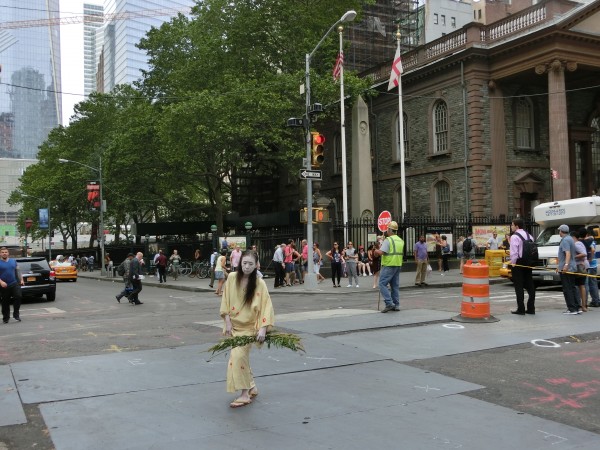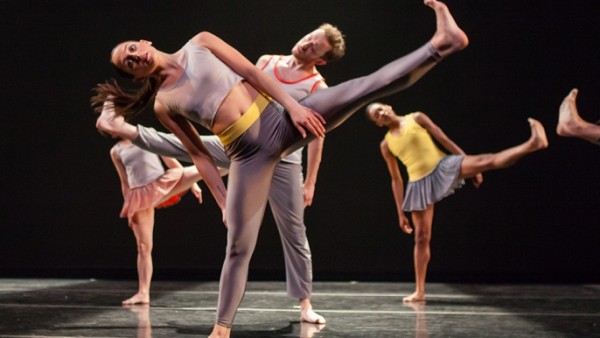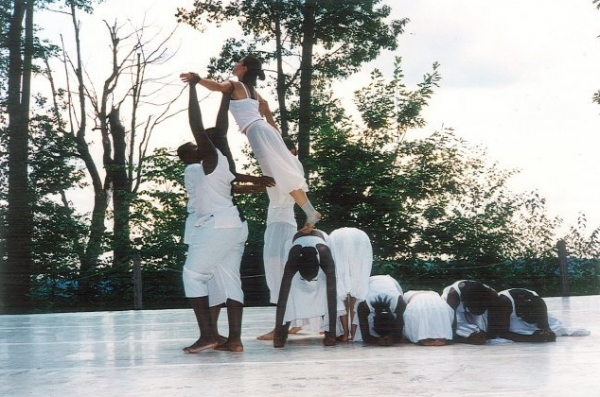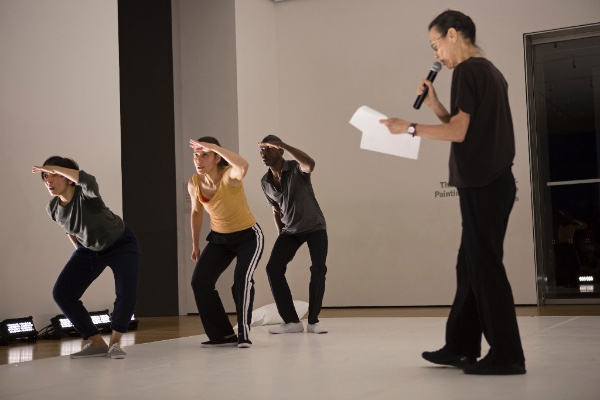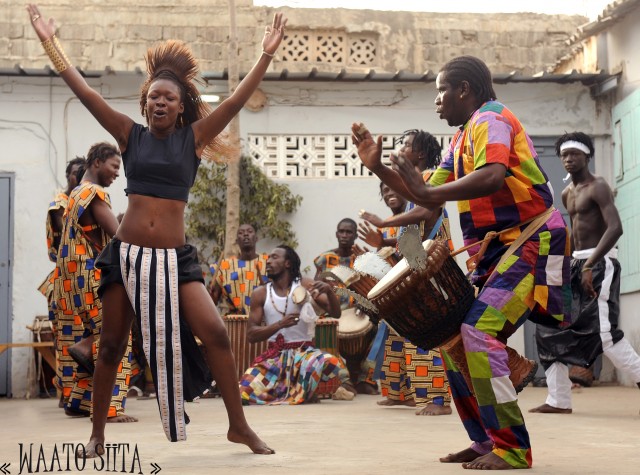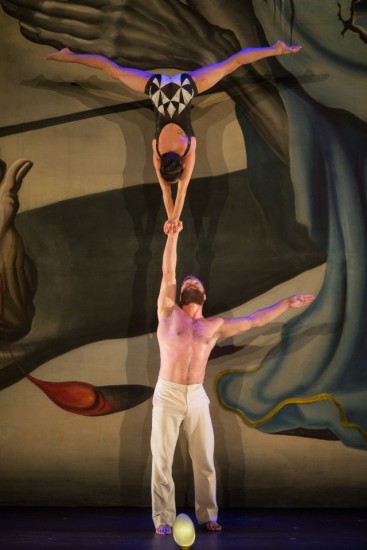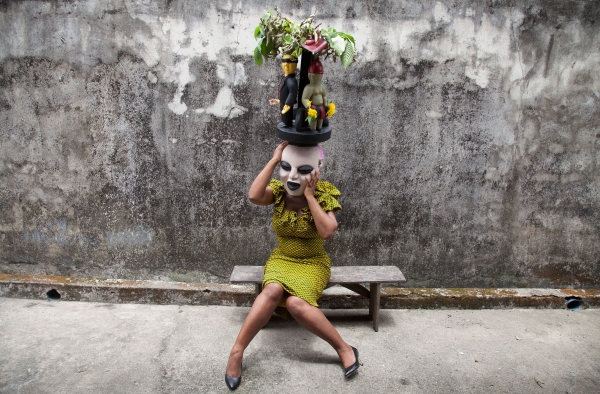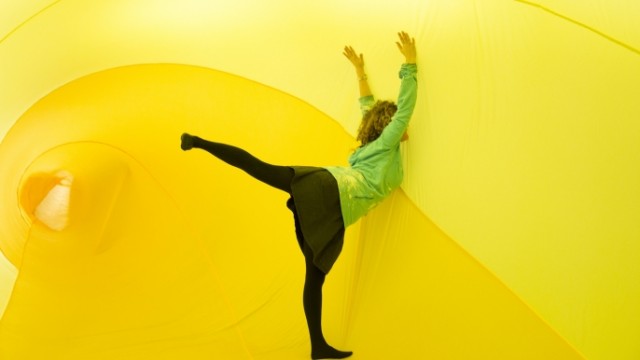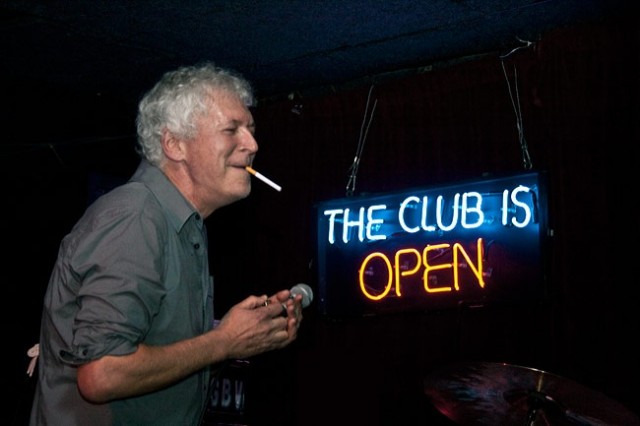
Robert Pollard will guide Guided by Voices into the South Street Seaport for headlining gig at 4Knots Festival
The weather is not exactly cooperating yet, but the free outdoor summer music season is upon us, as new announcements are made nearly every day about concerts and series around the five boroughs taking place between May and September. Below is a day-by-day look at who’s playing where, including SummerStage, Summer on the Hudson, Bryant Park, Governors Island, River to River, the Naumburg Orchestral Concerts, the Riis Park Beach Bazaar, the Northside Festival, Sessions at the Circle at the Shops at Columbus Circle, Hot Summer Nights! at Kingsborough Community College, Lincoln Center Out of Doors, Summer Sessions at Brookfield Place, Mad. Sq. Music in Madison Square Park, and Celebrate Brooklyn! Keep watching this space for more series as they are announced.
Saturday, May 21
Red Bull Music Academy Festival New York: Eddie Palmieri’s Harlem River Drive Revisited, Marcus Garvey Park, 2:30
Friday, May 27
Summer on the Hudson: Freshen Up Friday Concert Series with Elle Winston, West Harlem Piers, Riverside Park, 7:00
Saturday, May 28
Memorial Day Weekend at Riis Park Beach Bazaar: Simon & the Bar Sinisters with DJ Larry Flowers, Riis Park, 12 noon
Seaport Smorgasburg, with Flower Girl, Rips, Fulton Market Building, South Street Seaport, 3:00
Sunday, May 29
Memorial Day Weekend at Riis Park Beach Bazaar: the Supertones with DJ Mathcore, Riis Park, 12 noon
Seaport Smorgasburg, with Sheer Agony with special guest Erin Birgy (Mega Bog), Heavy Birds, Fulton Market Building, South Street Seaport, 3:00
Sailor Jerry Spiced Rum Fleet Week Block Party: Cage the Elephant, Pier 84, Hudson River Park, free with advance RSVP beginning May 25, 4:30
Rite of Summer Music Festival: Parker Quartet, Colonels Row, Governors Island, 1:00
Monday, May 30
Memorial Day Weekend at Riis Park Beach Bazaar: the Shipwrecks with DJ Mathcore, Riis Park, 12 noon
Seaport Smorgasburg, with Katie Von Schleicher, Patrick Freeman, Fulton Market Building, South Street Seaport, 3:00
NY Philharmonic Twenty-Fifth Annual Memorial Day Concert: A Tribute to Kurt Masur, with Alan Gilbert, Wynton Marsalis, and Thomas Hampson, Cathedral Church of St. John the Divine, Cathedral (live broadcast on Pulpit Green), 8:00
Thursday, June 2
BAM R&B Festival at MetroTech: Zapp, MetroTech Commons, 12 noon
Jazz at Socrates: The Alvin Flythe Quartet, Socrates Sculpture Park, 6:30
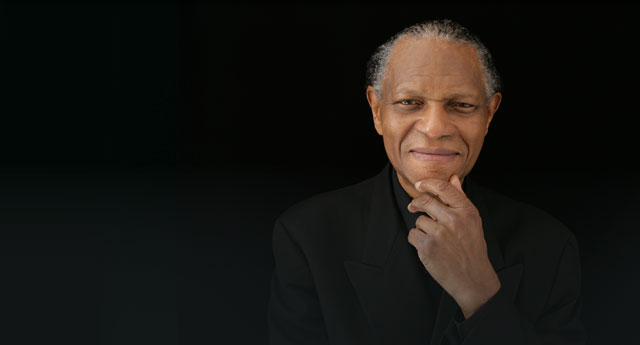
McCoy Tyner will be honored by fellow legends Ron Carter and Roy Haynes in Central Park on June 4
Saturday, June 4
SummerStage: Legends Honor McCoy: McCoy Tyner, Ron Carter, and Roy Haynes, Rumsey Playfield, Central Park, 6:00
Wednesday, June 8
Celebrate Brooklyn! Sharon Jones & the Dap-Kings, Prospect Park Bandshell, 8:15
Thursday, June 9
BAM R&B Festival at MetroTech: William Bell and Band, MetroTech Commons, 12 noon
Northside Festival: Wolf Parade, Land of Talk, McCarren Park, free with advance RSVP, 6:00
Arts, Culture & Fun: Taikoza Concert in the Park, Dekalb Ave. & South Portland Ave., 6:00
Friday, June 10
Northside Festival: Grandmaster Flash and special guests, McCarren Park, free with advance RSVP, 6:00
Sunset on the Hudson: Shanti Star & the Afro-Reggae All-Stars, Pier 45, Hudson River Park, 7:00
Saturday, June 11
Summer on the Hudson: AmpLit Amplifying Fresh Voices in Literature, with Jill Dearman, Nina Crews, Una LaMarche, Thomas Dooley, and more, Pier I, Riverside Park South, 11:00 am – 6:00 pm
Arts, Culture & Fun: Taikoza Concert in the Park, Orchard Beach in Pelham Bay Park, 2:00
SummerStage: Cymande, KING, Deva Mahal, DJ Parler, Rumsey Playfield, Central Park, 3:00
Celebrate Brooklyn! Ezra Jack Keats Family Concert: Dan Zanes’ Lead Belly Project, TADA! Youth Theater, Prospect Park Bandshell, 4:00
Arts, Culture & Fun: Concerts at Isham Park, with East Winds Ensemble performing the music of Masayo Ishigure and Marco Lienhard, Bruce’s Garden, 6:00
Saturday, June 11, and Sunday, June 12
Big Apple Barbecue Block Party, Madison Square Park, 11:00 am – 6:00 pm
Sunday, June 12
Ninth Annual Red Hook Jazz Festival, Urban Meadow Community Garden, 1:00 – 6:00
Scandinavian Music Festival Concert: The Scandia String Orchestra, Billings Lawn, Fort Tryon Park, 2:00
Arts, Culture & Fun: Concerts at Isham Park, with Taikoza, Bruce’s Garden, 6:00
Monday, June 13
SummerStage: screening of Afripedia and music by DJ Hard Hittin’ Harry, Saratoga Park, 7:00
Tuesday, June 14
SummerStage: Chairlift, Red Hook Park, 7:00
Naumburg Orchestral Concerts: Ensemble LPR — Opening Concert 2016, Naumburg Bandshell, Central Park, 7:30
Wednesday, June 15
SummerStage: Just Blaze and Friends, Red Hook Park, 7:00
SummerStage: Yiddish Soul: A Concert of Cantorial & Chassidic Superstars, Rumsey Playfield, Central Park, 7:00
NY Phil Concerts in the Parks: Alan Gilbert Conducts Rossini, Mozart, and R. Strauss, with clarinetist Anthony McGill, Great Lawn, Central Park, 8:00
Thursday, June 16
BAM R&B Festival at MetroTech: Mali Music, MetroTech Commons, 12 noon
SummerStage: Blonde Redhead, Red Hook Park, 7:00
Celebrate Brooklyn! Baaba Maal, Lakou Mizik, Prospect Park Bandshell, 7:30
NY Phil Concerts in the Parks: Alan Gilbert Conducts Beethoven and Wagner, Great Lawn, Central Park, 8:00
Friday, June 17
River to River Festival: M Is Black Enough, with cellist Jeffrey Zeigler, composer and percussionist Andy Akiho, poet Roger Bonair-Agard, and drummer Sean Dixon, Poets House, 6:00
Sunset on the Hudson: Chuck Braman Jazz Band, Pier 45, Hudson River Park, 7:00
SummerStage: Liza Jessie Peterson, LuQuantumleap, Red Hook Park, 7:00
NY Phil Concerts in the Parks: Alan Gilbert Conducts Beethoven and Mozart, with clarinetist Anthony McGill, Long Meadow, Prospect Park, 8:00
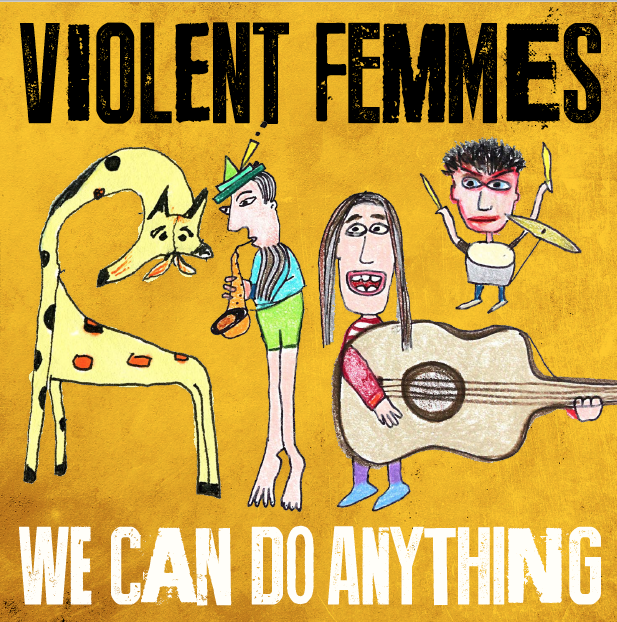
The Violent Femmes will show they can do anything at Brooklyn gig on June 18
Saturday, June 18
Make Music New York: Porch Stomp, Nolan Park, Governors Island, 12 noon – 5:00 pm
Corona Electric Beach: Jillionaire, DJ Belinda Becker, Lion Dub, Jimmy at the James Hotel rooftop lounge, free with advance RSVP to info@findyourelectricbeach.com, 3:00
SummerStage: Kamasi Washington, preshow panel discussion, Rumsey Playfield, Central Park, 6:00
Celebrate Brooklyn! Violent Femmes, Kristin Hersh, Prospect Park Bandshell, 7:30
Sunday, June 19
Make Music New York: Punk Island, Parade Ground, Governors Island, 12 noon – 5:00 pm
Ninth Annual Red Hook Jazz Festival, Urban Meadow Community Garden, 1:00 – 6:00
Scandinavian Music Festival Concert: Songs of Scandinavia, with Thomas Storm and Mette-Maria Oyen, Billings Lawn, Fort Tryon Park, 2:00
SummerStage: DJ Rich Medina, RAAA, Urban Word & Hi-Arts: Journal to Journey, Ziearre, Red Hook Park, 4:00
River to River: Black Wall Street, by Alicia Hall Moran, Federal Hall, 7:00
Monday, June 20
SummerStage: Screening of In My Father’s House (Ricki Stern & Anne Sundberg, 2015), followed by Q&A with film subject Rhymefest, Saratoga Park, 7:00
River to River: Black Wall Street, by Alicia Hall Moran, Federal Hall, 7:00
NY Phil Concerts in the Parks: Alan Gilbert Conducts Rossini, Mozart, and R. Strauss, with clarinetist Anthony McGill, Cunningham Park, 8:00
Tuesday, June 21
Summer on the Hudson: Tenth Annual Make New York Presents Glass on Water, Pier I, Riverside Park South, 5:00 – 10:00
SummerStage: Fête de la Musique, with Charlélie Couture, Yael Naim, General Elektriks, and La Femme, Rumsey Playfield, Central Park, 6:00
SummerStage: Public Enemy, DJ Tedsmooth, Betsy Head Park, 7:00
NY Phil Concerts in the Parks: Alan Gilbert Conducts Rossini, Mozart, and R. Strauss, with clarinetist Anthony McGill, Van Cortlandt Park, 8:00
Wednesday, June 22
SummerStage: Angie Stone, DJ Chuck Chillout, Betsy Head Park, 7:00
River to River: Krai, by Olga Bell, 28 Liberty, 8:00
SummerStage: Metropolitan Opera Summer Recital Series, featuring Angel Blue, Ben Bliss, Alexey Lavrov, and Dan Saunders, Rumsey Playfield, Central Park, 8:00
Thursday, June 23
BAM R&B Festival at MetroTech: The Fat Afro Latin Jazz Cats, MetroTech Commons, 12 noon
SummerStage: Duck Down BBQ, Betsy Head Park, 7:00
Celebrate Brooklyn! Alvvays, Ducktails, Big Thief, Prospect Park Bandshell, 7:00
Friday, June 24
SummerStage: Nuyorican Poets Café, with Mahogany Browne’s Redbone, reg e gaines’s the Last Celebrity, Betsy Head Park, 7:00
Sunset on the Hudson: Max Gallico & Friends, Pier 45, Hudson River Park, 7:00
Summer on the Hudson: Freshen Up Friday Concert Series with Tattoo Money, West Harlem Piers, Riverside Park, 7:00
Celebrate Brooklyn!¡Cubanismo!, Ricardo Lemvo & Makina Loca, Prospect Park Bandshell, 7:30
Friday, June 24
SummerStage: Metropolitan Opera Summer Recital Series, featuring Angel Blue, Ben Bliss, Alexey Lavrov, and Dan Saunders, Brooklyn Bridge Park, 7:00
Saturday, June 25
Rite of Summer Music Festival: Jeffrey Ziegler with Ian David Rosenbaum, Nolan Park, Governors Island, 1:00
SummerStage: Butler, Bernstein, & the Hot 9, the Hot Sardines, Bria Skonberg and the New York Hot Jazz Festival All-Stars with Anat Cohen, Vince Giordano, Wycliffe Gordon, Joe Saylor, and Dalton Ridenhour, Rumsey Playfield, Central Park, 2:00
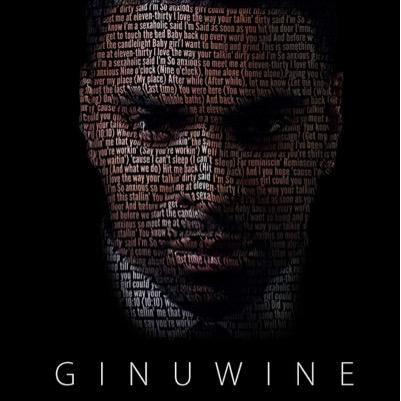
Ginuwine will be in Flushing Meadows Corona Park on June 26
Sunday, June 26
Scandinavian Music Festival Concert: Scandia Brass Quintet, Billings Lawn, Fort Tryon Park, 2:00
SummerStage: Christian Cultural Center C3 Choir, Mr. Reed, Boots Step Team, DJ Styff, Betsy Head Park, 4:00
SummerStage: Only in Queens Summer Festival, with Ginuwine, Mack Wilds, Kid ’n Play, Flushing Meadows Corona Park, 5:00
SummerStage: DJ Gringo and screening of Queen Nanny: Legendary Maroon Chieftainess (Roy T. Anderson, 2015), Betsy Head Park, 7:00
Monday, June 27
SummerStage: Felix Hernandez’s Rhythm Revue and screening of 20 Feet from Stardom (Morgan Neville, 2013), Saratoga Park, 7:00
SummerStage: Indigo Girls, Rumsey Playfield, Central Park, 7:00
Tuesday, June 28
SummerStage: Lisa Simone and screening of What Happened, Miss Simone? (Liz Garbus, 2015), Herbert Von King Park, 7:00
Naumburg Orchestral Concerts: Orpheus Chamber Orchestra, Naumburg Bandshell, Central Park, 7:30
Wednesday, June 29
SummerStage: Screening of A Ballerina’s Tale (Nelson George, 2015), with Jeremy McQueen’s Black Iris Project and preshow panel discussion, Rumsey Playfield, Central Park, 8:00
SummerStage: Soul in the Horn featuring Theo Croker, Maurice Mobetta Brown, Marcus Machado, Kendra Foster, and DJ Natasha Diggs, hosted by DProsper, Herbert Von King Park, 7:00
Thursday, June 30
BAM R&B Festival at MetroTech: George Gray Groove Coalition, MetroTech Commons, 12 noon
SummerStage: Vivian Green, Grand Wizzard Theodore, Herbert Von King Park, 7:00
Saturday, July 2
SummerStage: Freedom Party Thirteenth Anniversary, Rumsey Playfield, Central Park, 7:00
SummerStage: Everyday People, Herbert Von King Park, 7:00
Hot Summer Nights! On Stage at Kingsborough: The Glenn Crytzer Orchestra with special guest Lindy Hoppers from the Syncopated City Dance Company, Kingsborough Lighthouse Bandshell, 8:00
Sunday, July 3
SummerStage: King Sunny Adé, Orlando Julius and the Afro Soundz, DJ Rich Medina, Rumsey Playfield, Central Park, 3:00
Summer on the Hudson: Amplified Sundays, with Irka Mateo y la Tirindanga, Pier I, Riverside Park South, 7:00
SummerStage: Trouble Funk, Operator Emz, Herbert Von King Park, 7:00
Tuesday, July 5
SummerStage: George Lamond, DJ Lucho, Crotona Park, 7:00
Wednesday, July 6
SummerStage: Mexrrissey, Los Cafres, La Dame Blanche, Rumsey Playfield, Central Park, 6:00
SummerStage: Fat Joe, Tony Touch, hosted by Lyricist Lounge, Crotona Park, 7:00
Thursday, July 7
BAM R&B Festival at MetroTech: Fatback Band, MetroTech Commons, 12 noon
Broadway in Bryant Park: Wicked, Stomp, The Color Purple, Matilda, Bryant Park lawn, 12:30
Jazz at Socrates: Aqua Ninjaz Dynamic Tribute Ensemble, Socrates Sculpture Park, 6:30
SummerStage: Tribute to Latin Jazz Great Dave Valentin, Crotona Park, 7:00
SummerStage: Metropolitan Opera Summer Recital Series, with Michelle Bradley, Kang Wang, Yunpeng Wang, and Dan Saunders, Clove Lakes Park, 7:00
Celebrate Brooklyn! Red Baraat’s Brooklyn Mela, with DJ Rekha, Heems, Bhi Bhiman, & More, Prospect Park Bandshell, 7:30
New Image Band, George Seuffert Bandshell, Forest Park, 7:30
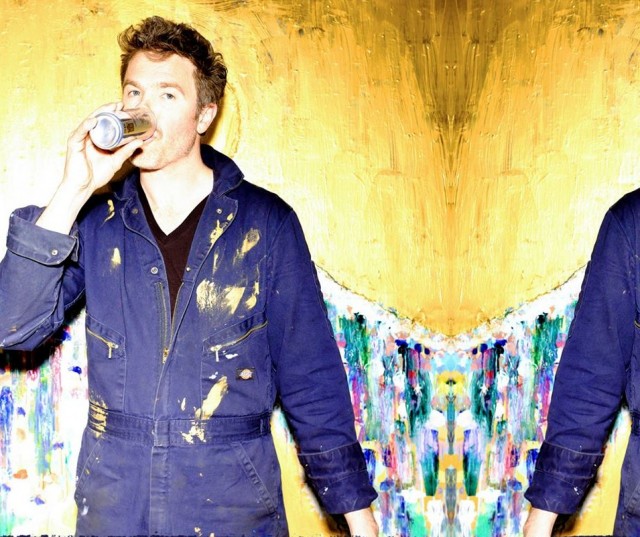
Josh Ritter and his Royal City Band will be in Prospect Park on July 8
Friday, July 8
SummerStage: Leon Larregui, Rodrigo Amarante, Grenda, Rumsey Playfield, Central Park, 6:00
Sunset on the Hudson: Shanti Star & the Afro-Reggae All-Stars, Pier 45, Hudson River Park, 7:00
Celebrate Brooklyn! Josh Ritter & the Royal City Band, Martha Redbone, Birds of Chicago, Prospect Park Bandshell, 7:00
SummerStage: Nuyorican Poets Cafe: Craig ‘muMs’ Grant’s “A Sucker Emcee,” Crotona Park, 7:00
Saturday, July 9
4Knots Music Festival, with Guided by Voices, the Strumbellas, Protomartyr, Car Seat Headrest, Kirk Knight, Girlpool, Bayonne, Diane Coffee, Promised Land Sound, Mile High Club, and more, South Street Seaport, 1:00 – 8:00
Columbia Summer Winds Concert, Billings Lawn, Fort Tryon Park, 2:00
SummerStage: Acrobuffos, Rob & Miss Jane, Sxip’s Hour of Charm, It’s Showtime NYC, Crotona Park, 7:00
Celebrate Brooklyn! Carla Morrison, Hurray for the Riff Raff, Buscabulla, Prospect Park Bandshell, 7:00
SummerStage: Metropolitan Opera Summer Recital Series, with Michelle Bradley, Kang Wang, Yunpeng Wang, and Dan Saunders, Jackie Robinson Park, 7:00
Hot Summer Nights! On Stage at Kingsborough: Davina and the Vagabonds, Kingsborough Lighthouse Bandshell, 8:00
Sunday, July 10
SummerStage: Justin Roberts & the Not Ready for Naptime Players, Mister G, Excerpts from Finding Neverland, Gizmo Guys, Rumsey Playfield, Central Park, 3:00
Summer on the Hudson: Amplified Sundays, with Bella’s Bartok, Pier I, Riverside Park South, 7:00
SummerStage: DJ Kool Herc, Little Shalimar, and screening of Rubble Kings (Shan Nicholson, 2010), Crotona Park, 7:00
Monday, July 11
SummerStage: The Metropolitan Opera Summer Recital Series, with Michelle Bradley, Kang Wang, Yunpeng Wang, and Dan Saunders, Socrates Sculpture Park, 7:00
Tuesday, July 12
SummerStage: Johnny Rivera, Joan Català, St. Mary’s Park, 7:00
Naumburg Orchestral Concerts: The Knights, Naumburg Bandshell, Central Park, 7:30
Tuesday, July 12, and Wednesday, July 13
Lowdown Hudson Music Fest: Brookfield Place Waterfront Plaza, doors at 5:00
Wednesday, July 13
Around the Park @ Lunch: Found Sound Nation — Street Studio City, Madison Square Park, 12:30
SummerStage: Joe Bataan meets Setenta, Joan Català, St. Mary’s Park, 7:00
SummerStage: The Metropolitan Opera Summer Recital Series, with Michelle Bradley, Kang Wang, Yunpeng Wang, and Dan Saunders, Crotona Park, 7:00
Thursday, July 14
Concerts for Kids: Sonia de los Santos, Madison Square Park, 10:30
BAM R&B Festival at MetroTech: King Sunny Ade, MetroTech Commons, 12 noon
Broadway in Bryant Park: Chicago, The Fantastiks, Motown, Finding Neverland, Bryant Park lawn, 12:30
SummerStage: Tito Rojas, St. Mary’s Park, 7:00
Celebrate Brooklyn! Music & Movies: Triplets of Belleville (Sylvain Chomet, 2003), Jessica Fichot, Prospect Park Bandshell, 8:00
Friday, July 15
Bryant Park Presents INTERSECT: Kit of Parts, with the Westerlies, Ben Monder, Rabbit Rabbit (Carla Kihlstedt & Matthias Bossi), Argus String Quartet, and Ethan Iverson, Bryant Park Stage, 5:00 – 10:00
SummerStage: Felix Hernandez’s Rhythm Revue, screening of We Like It Like That: The Story of Latin Boogaloo (Mathew Ramirez Warren, 2015), St. Mary’s Park, 7:00
Sunset on the Hudson: Max Gallico & Friends, Pier 45, Hudson River Park, 7:00
Celebrate Brooklyn! Rachid Taha, Krar Collective, Prospect Park Bandshell, 7:30
Saturday, July 16
Louis Armstrong’s Wonderful World, with Dr. John, Kermit Ruffins, and Soulive, Flushing Meadows Corona Park, free with advance registration, 1:00 – 8:00
Hudson RiverStage: Deer Tick acoustic, Margo Price, Anaïs Mitchell, Chrome Pony, and Breanna Barbara, Pier 97, Hudson River Park, 2:00
SummerStage: Taiwanese Waves, with Anpu, Wonfu, Sunset Rollercoaster, Rumsey Playfield, Central Park, 6:00
Celebrate Brooklyn! The Wood Brothers, Aoife O’donovan, Hiss Golden Messenger, Prospect Park Bandshell, 7:00
Hot Summer Nights! On Stage at Kingsborough: Tammy McCann & the Sharp Radway Big Band, Kingsborough Lighthouse Bandshell, 8:00
SummerStage: Full Circle Souljahs presents “From the Streets to the Stage,” Behind the Groove, preshow master class with Kwikstep & Rokafella, St. Mary’s Park, 7:00
Sunday, July 17
SummerStage: Paulo Flores, Herencia de Timbiquí, Monsieur Periné, DJ Greg Caz, DJ Manny, Rumsey Playfield, Central Park, 3:00
SummerStage: Legacy Women, Recess Monkey, Music with a Message, Double Dutch Dreamz, St. Mary’s Park, 4:00
Luna Park Entertainment Summer Series: Ellise Gitas, Luna Park, Coney Island, 4:00
Plastic Soul, George Seuffert Bandshell, Forest Park, 5:00
Summer on the Hudson: Amplified Sundays, with DeLeon, Pier I, Riverside Park South, 7:00
Monday, July 18
SummerStage: The Feelies, Beach Fossils, Rumsey Playfield, Central Park, 7:00
Tuesday, July 19
Summer Sessions: Panama Wedding, Upper Waterfront Plaza at Brookfield Place, DJs at 5:00, concert at 6:30
Naumburg Orchestral Concerts: The Knights, Naumburg Bandshell, Central Park, 7:30
Wednesday, July 20
Summer Sessions: Spirit Family Reunion, Upper Waterfront Plaza at Brookfield Place, DJs at 5:00, concert at 6:30
Lincoln Center Out of Doors: A Night of Words and Music with Patti Smith, Lenny Kaye, and Tony Shanahan, and Mariachi Flor de Toloache, Damrosch Park, 7:30
Thursday, July 21
Concerts for Kids: Trout Fishing in America, Madison Square Park, 10:30
BAM R&B Festival at MetroTech: The Hallelujah Train, MetroTech Commons, 12 noon
Broadway in Bryant Park: Fiddler on the Roof, Les Miserables, Fuerza Bruta, The Marvelous Wonderettes, Paramour, Bryant Park lawn, 12:30
Around the Park @ Nite: Akim Funk Buddha, Madison Square Park, 7:00
Lincoln Center Out of Doors: The Hallelujah Train featuring Pastor Brady Blade Sr., Brian Blade, Daniel Lanois, and guests Ladysmith Black Mambazo, Damrosch Park, 7:30
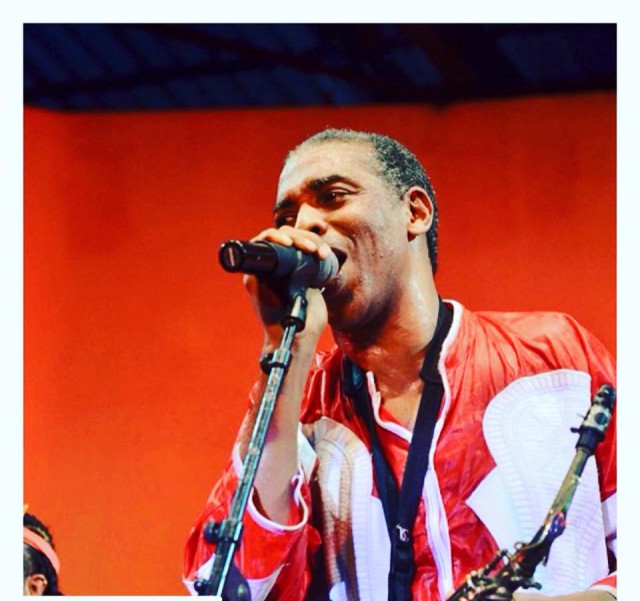
Femi Kuti will celebrate Brooklyn and more on July 22
Friday, July 22
Sunset on the Hudson: Chuck Braman Jazz Band, Pier 45, Hudson River Park, 7:00
Lincoln Center Out of Doors: Mostly Mozart Festival Orchestra, conducted by Louis Langrée, with violinist Simone Porter playing Mozart’s “Jupiter” Symphony, Damrosch Park, 7:30
Celebrate Brooklyn! Femi Kuti, Bombino, Prospect Park Bandshell, 7:30
Saturday, July 23
Lincoln Center Out of Doors Family Day: Lincoln Center Block Party with Illstyle & Peace Productions, Josie Robertson Plaza, 11:00 am
Rite of Summer Music Festival: Kara Sainz and Peter Dugan, Nolan Park, Governors Island, 1:00
Lincoln Center Out of Doors Family Day: Dance Theatre of Harlem Company and School, Josie Robertson Plaza, 1:00
Lincoln Center Out of Doors Family Day: Illstyle & Peace Productions, Hearst Plaza, 1:00
Lincoln Center Out of Doors Family Day — She’s a Rebel: The Girl Group Project, featuring Nanette Licari, Lillian Walker Moss, Louise Murray, Beverly Warren, Margaret Ross Williams, and She’s a Rebel student participants, Josie Robertson Plaza, 3:00
Garden Grooves, Bedford Stuyvesant Community Garden, 6:00
Celebrate Brooklyn! Jon Batiste and Stay Human & Friends, Prospect Park Bandshell, 7:30
Lincoln Center Out of Doors: An Evening with Darlene Love, Damrosch Park, 7:30
Hot Summer Nights! On Stage at Kingsborough: Svetlana & the Delancey Six, with special guest tap star Michela Marino Lerman, Kingsborough Lighthouse Bandshell, 8:00
Sunday, July 24
Lincoln Center Out of Doors — Heritage Sunday Global Beat of the Bronx: From Bambara to Breakbeats, with Bambara Drum and Dance Ensemble, Bombazo Dance Company, Chief Joseph Chatoyer Dance Company, and Full Circle Souljahs, Hearst Plaza, 1:00
Summer on the Hudson: Amplified Sundays, with Michael Arenella & Quintet, Pier I, Riverside Park South, 7:00
Lincoln Center Out of Doors: Richie Ray and Bobby Cruz, Miramar, Damrosch Park, 7:30
Tuesday, July 26
Summer Sessions: Kate Davis, Upper Waterfront Plaza at Brookfield Place, DJs at 5:00, concert at 6:30
Sessions at the Circle: Camille Thurman with the Darrell Green Trio, the Shops at Columbus Circle, second floor mezzanine, 6:00
SummerStage: Black Moon & Smif-N-Wessun performing a tribute to Enta Da Stage & Dah Shinin’, Queensbridge Park, 7:00
Wednesday, July 27
Summer Sessions: Upper Waterfront Plaza at Brookfield Place, DJs at 5:00, concert at 6:30
Lincoln Center Out of Doors: AfroPunk’s Girrrl Riot @ Lincoln Center, with SATE and the VeeVees, Damrosch Park, 7:00
SummerStage: Dianne Reeves, DJ Greg Caz, Queensbridge Park, 7:00
Lincoln Center Out of Doors: Dane Terry, Hearst Plaza, 7:00
Thursday, July 28
Concerts for Kids: the Not-Its!, Madison Square Park, 10:30
BAM R&B Festival at MetroTech: Ladies Sing the Blues, with Catherine Russell, Charenee Wade, and Brianna Thomas, MetroTech Commons, 12 noon
Broadway in Bryant Park: Waitress, Natasha, Pierre and the Great Comet of 1812, Kinky Boots, Fun Home, Himself & Nora, Bryant Park lawn, 12:30
Lincoln Center Out of Doors: Jaime Woods, Hearst Plaza, 7:00
SummerStage: Lyfe Jennings, Queensbridge Park, 7:00
Lincoln Center Out of Doors: Maurice Hines Tappin’ Thru Life, Michael Mwenso & the Shakes, Damrosch Park, 7:30
Paul & the Goodfellas, George Seuffert Bandshell, Forest Park, 7:30
Lincoln Center Out of Doors: Eli “Paperboy” Reed, Hearst Plaza, 7:30
Celebrate Brooklyn! Gregory Porter, Marcus Strickland & Twi-Life, Prospect Park Bandshell, 7:30
Friday, July 29
Summer on the Hudson: Freshen Up Friday Concert Series with Consumata Sonidera, West Harlem Piers, Riverside Park, 7:00
SummerStage: Nuyorican Poets Cafe: Paolo Javier and Maria Lisella hosting Queens Poets, Queensbridge Park, 7:00
Lincoln Center Out of Doors: Okayafrica: Afrobeat x Afrobeats, with Davido and Antibalas, Damrosch Park, 7:30
Celebrate Brooklyn! Angelique Kidjo’s Celia Cruz Tribute with Pedrito Martinez, Yosvany Terry Quintet, Prospect Park Bandshell, 7:30
Saturday, July 30
Lincoln Center Out of Doors — The Bells: A Daylong Celebration of Lou Reed, Damrosch Park
Eighth Annual Stan Michels Memorial Jazz Concert, with Marjorie Eliot and her ensemble, Stan Michels Promenade, Fort Tryon Park, 1:00
Lincoln Center Out of Doors: La Casita at Teatro Pregones, 571 Walton Ave., the Bronx, 2:30
SummerStage: Stefanie Batten Bland with Burnt Sugar the Arkestra Chamber, preshow master class with Karisma Jay, Queensbridge Park, 7:00
Luna Park Entertainment Summer Series: DJ Saasha Foo, Luna Park, Coney Island, 7:00
SummerStage: Unknown Mortal Orchestra, Empress Of, Rumsey Playfield, Central Park, 7:00
Celebrate Brooklyn! Digable Planets, Camp Lo, Prospect Park Bandshell, 7:30
Sunday, July 31
Lincoln Center Out of Doors: La Casita, Hearst Plaza, 12 noon
SummerStage: Marc Cary: The Harlem Jam Sessions, Joseph Webb: Dancing Buddhas, WBGO Kids Jazz with Brianna Thomas & the Jazz Travelers, Queensbridge Park, 4:00
Summer on the Hudson: Amplified Sundays, with JoJo Abot, Pier I, Riverside Park South, 7:00
Lincoln Center Out of Doors: Songs of Freedom, with Ky-Mani Marley and Finotee, Damrosch Park, 7:00
SummerStage: Rock Steady Crew Thirty-Ninth Anniversary with Nice & Smooth, Bahamadia, Doug E. Fresh, and more, Rumsey Playfield, Central Park, 7:00
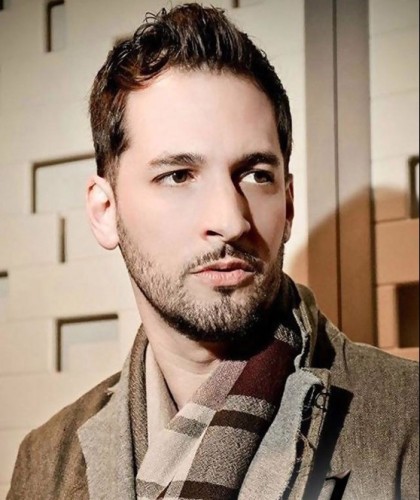
Jon B will be at Cloves Lake Park in Staten Island on August 2
Tuesday, August 2
Sessions at the Circle: Riley Mulherkar Quartet, the Shops at Columbus Circle, second floor mezzanine, 6:00
SummerStage: Jon B, Clove Lakes Park, 7:00
Naumburg Orchestral Concerts: ECCO, East Coast Chamber Orchestra, Naumburg Bandshell, Central Park, 7:30
Wednesday, August 3
SummerStage: Screening of Kirikou and the Wild Beasts (Michel Ocelot & Bénédicte Galup, 2005), Orisha’s Journey, DJ Djib Sayo, Clove Lakes Park, 7:00
Lincoln Center Out of Doors: Soledad Barrio and Noche Flamenca, and Manhattan Camerata: Tango Fado Project featuring Nathalie Pires, Damrosch Park, 7:00
Thursday, August 4
BAM R&B Festival at MetroTech: Dee Dee Bridgewater, MetroTech Commons, 12 noon
Broadway in Bryant Park: Beautiful, An American in Paris, Avenue Q, Holiday Inn, Bryant Park lawn, 12:30
Jazz at Socrates: Louis Armstrong Night with “Hot Lips” Joey Morant, Socrates Sculpture Park, 6:30
SummerStage: Jungle Brothers, G-Bo the Pro, Clove Lakes Park, 7:00
Lincoln Center Out of Doors: NPR Music Live in Concert, hosted by Bob Boilen and Robin Hilton, Felix Contreras, and Jasmine Garsd, Damrosch Park, 7:00
Temptations Revue Featuring Grammy Award Winner Barrington Henderson, George Seuffert Bandshell, Forest Park, 7:30
Celebrate Brooklyn! Music & Movies: Run Lola Run (Tom Tykwer, 1999) with U.S. premiere of live score by the Bays, Joan as Police Woman, Benjamin Lazar Davis, Prospect Park Bandshell, 7:30
Friday, August 5
SummerStage: Terence Blanchard featuring the E-Collective, Clove Lakes Park, 7:00
Lincoln Center Out of Doors: Zé Renato with special guests Vinícius Cantuária and Ricardo Silveira, Hearst Plaza, 7:00
Sunset on the Hudson: Chuck Braman Jazz Band, Pier 45, Hudson River Park, 7:00
Lincoln Center Out of Doors: M. Ward, Margaret Glaspy, Damrosch Park, 7:30
Celebrate Brooklyn! Morgan Heritage, British Dependency, Prospect Park Bandshell, 7:30
Saturday, August 6
Luna Park Entertainment Summer Series: Apostrophe Base 12 Party, Luna Park, Coney Island, 1:00
Hudson RiverStage: William Bell, the James Hunter Six, George Porter Jr. & Runnin’ Pardners, Taylor McFerrin, and Soul Clap & Dance-Off with DJ Jonathan Toubin and special guests, Pier 97, Hudson River Park, 2:00
Garden Grooves, Greene Acres Community Garden, 6:00
SummerStage: Monobloco, Cabruêra, Boogarins, DJ Luiz Santos, preshow panel discussion, Rumsey Playfield, Central Park, 6:00
Celebrate Brooklyn! The Hubble Cantata, Tigue, Prospect Park Bandshell, 7:30
Sunday, August 7
SummerStage: Secret Agent 23 Skidoo, Sierra Leone Dance Troupe, Wahoo Skiffle Crazies, Clove Lakes Park, 4:00
SummerStage: Igmar Thomas & the Revive Big Band present “A Journey Through the Legacy of Black Culture,” with preshow panel discussion, Rumsey Playfield, Central Park, 7:00
Tuesday, August 9
Sessions at the Circle: Jazz for Young People, the Shops at Columbus Circle, second floor mezzanine, 6:00
SummerStage: Neon Indian, East River Park, 7:00
Wednesday, August 10
SummerStage: “We Play for you, Butch Morris,” featuring Nublu Orchestra, DarkMatterHalo with Wadada Leo Smith, screening of Black February (Vipal Monga, 2014), East River Park, 7:00
Celebrate Brooklyn! Music & Movies: Labyrinth (Jim Henson, 1986), Donny McCaslin Group, Prospect Park Bandshell, 7:30
SummerStage: Tamar-kali with ASE Dance Theatre Collective, Nathan Trice Rituals, Rumsey Playfield, Central Park, 8:00
Thursday, August 11
Broadway in Bryant Park: Phantom of the Opera, Something Rotten, Cagney, Ruthless!, Bryant Park lawn, 12:30
SummerStage: Roberto Roena y Su Apollo Sound, East River Park, 7:00
Friday, August 12
Sunset on the Hudson: Shanti Star & the Afro-Reggae All-Stars, Pier 45, Hudson River Park, 7:00
Celebrate Brooklyn! Dr. Dog with the Knights, Prospect Park Bandshell, 7:30
Saturday, August 13
Lincoln Center Out of Doors / Mostly Mozart: the public domain, David Lang’s Crowd Out performed by Birmingham Contemporary Music Group, conducted by Simon Halsey, with movement by Annie-B Parson, Josie Robertson Plaza, 5:00
Celebrate Brooklyn! Andra Day, Son Little, Prospect Park Bandshell, 7:30
Sunday, August 14
SummerStage: Mbongwana Star, Batida, Young Paris Okayafrica Electrafique with DJ Underdog, preshow panel discussion, Rumsey Playfield, Central Park, 6:00
SummerStage: DJ Spinna Celebrating Earth Wind & Fire, Shine & the Moonbeams, East River Park, 4:00
Tuesday, August 16
Sessions at the Circle: Christie Dashiell Quartet, the Shops at Columbus Circle, second floor mezzanine, 6:00
SummerStage: Alpha Blondy, Marcus Garvey Park, 7:00
Wednesday, August 17
SummerStage: Saul Williams, Kimberly Nichole, Marcus Garvey Park, 7:00
SummerStage: DJ KS 360 & Full Circle Souljahs presents Behind the Groove, Soul Connected, Raphael Xavier, Rumsey Playfield, Central Park, 8:00
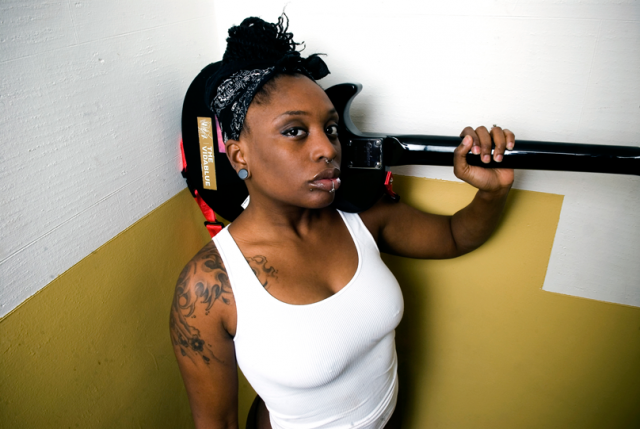
Tamar-kali teams up with ASE Dance Collective in Marcus Garvey Park on August 18
Thursday, August 18
SummerStage: Tamar-kali with ASE Dance Collective, preshow master class with Calvin Wiley, Marcus Garvey Park, 7:00
Around the Park @ Nite: Phyllis Chen, Madison Square Park, 7:00
Friday, August 19
Bryant Park Presents Emerging Music Festival, Bryant Park Stage, 5:00 – 10:00
Sunset on the Hudson: Max Gallico & Friends, Pier 45, Hudson River Park, 7:00
Saturday, August 20
Luna Park Entertainment Summer Series: SheRoxxx, Luna Park, Coney Island, 5:00
Garden Grooves, Bedford Stuyvesant Community Garden, 6:00
Summer on the Hudson: FlyNYC, family kite festival with live music, Pier I, Riverside Park South, 7:00
Saturday, August 20 & Sunday, August 21
Hudson River Park seventeenth annual Blues BBQ, with Gaye and the Wild Rutz, Cash Box Kings, Bernard Allison Group, Sugaray Rayford Band, the Dirty Dozen Brass Band, and restaurants Arrogant Swine, Dinosaur Bar-B-Que, Fort Gansevoort BBQ, Mighty Quinn’s Barbecue, Pier 97, Hudson River Park, 2:00 – 9:00
Jazz Festival, Morris-Jumel Mansion, Roger Morris Park, 2:00
Sunday, August 21
SummerStage: Sweet Micky, MHD, DJ Erick La Peau, Rumsey Playfield, Central Park, 3:00
SummerStage: Kalabantè Circus, Iron Skulls & Quim Moya, Sxip’s Hour of Charm, Marcus Garvey Park, 7:00
Tuesday, August 23
Sessions at the Circle: the Curtis Brothers Quartet, the Shops at Columbus Circle, second floor mezzanine, 6:00
Friday, August 26
Bryant Park Presents INTERSECT, Bryant Park Stage, 5:00 – 10:00
SummerStage: Jason Lindner: Breeding Ground, DJ Greg Caz, Marcus Garvey Park, 7:00
Summer on the Hudson: Freshen Up Friday Concert Series: The Bones of J. R. Jones, West Harlem Piers, Riverside Park, 7:00
Saturday, August 27
Rite of Summer Music Festival: Inuksuit, Nolan Park, Governors Island, 1:00
SummerStage: Randy Weston African Rhythms Sextet, Cory Henry & the Funk Apostles, the Artistry of Jazzmeia Horn, Charles Turner III, preshow master class with Samuel Coleman, Marcus Garvey Park, 3:00
Sunday, August 28
SummerStage: DeJohnette – Moran – Holland, Allan Harris, Donnie McCaslin Group, Grace Kelly, Tompkins Square Park, 3:00
SummerStage: Goldlink, Backyard Band, DJ Spicoli, Rumsey Playfield, Central Park, 3:00
Tuesday, August 30
Sessions at the Circle: Fleur Seule, the Shops at Columbus Circle, second floor mezzanine, 6:00
Wednesday, August 31
SummerStage: Chicago the Musical: 20th Anniversary Concert, Rumsey Playfield, Central Park, 8:00
